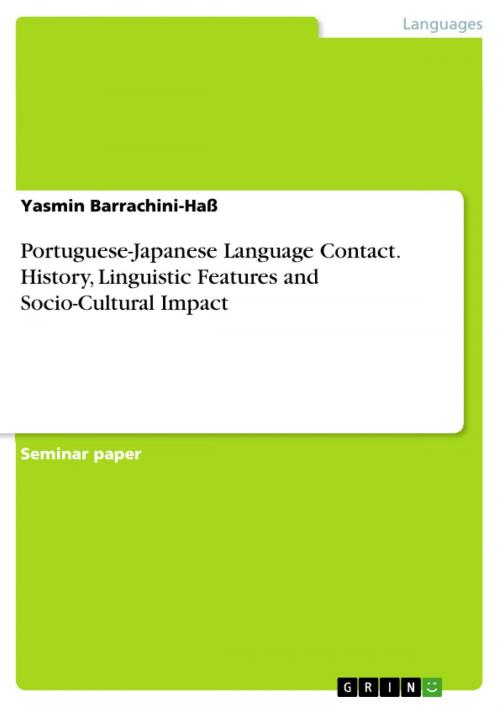Portuguese-Japanese Language Contact. History, Linguistic Features and Socio-Cultural Impact
Nonfiction, Reference & Language, Language Arts, Linguistics| Author: | Yasmin Barrachini-Haß | ISBN: | 9783668198920 |
| Publisher: | GRIN Verlag | Publication: | April 18, 2016 |
| Imprint: | GRIN Verlag | Language: | English |
| Author: | Yasmin Barrachini-Haß |
| ISBN: | 9783668198920 |
| Publisher: | GRIN Verlag |
| Publication: | April 18, 2016 |
| Imprint: | GRIN Verlag |
| Language: | English |
Seminar paper from the year 2013 in the subject Speech Science / Linguistics, grade: 1,7, University of Bremen, course: Leitmotive in der Kontaktlinguistik, language: English, abstract: Language contact between Japanese and Portuguese is not a recent phenomenon. During Japan's 'Christian Era' between 1549 and 1639, the introduction of foreign culture by Portuguese missionaries and merchants influenced not only such fields as religion, technology and art, but also the Japanese language. The language contact continued over the past centuries and reached a further peak at the beginning of the twentieth century. Up to this point, there still is a quite vivid interaction between Brazilians and Japanese for several reasons, which will be presented in the third chapter. Besides, the number of Brazilian residents in Japan and vice versa is so high nowadays that the contact between those two languages is practically inevitable. The history of Portuguese-Japanese language contact is divided into three stages. These aforesaid stages will be discussed as follows: The first chapter deals with the first stage of language contact, which occurred in the sixteenth century in Japan. Chapter two is about the second stage of Portuguese-Japanese language contact, which occurred in Brazil at the beginning of the twentieth century. The third chapter deals with the third and last stage of Japanese-Portuguese language contact that began at the end of the twentieth century and still continues. This chapter is followed by a conclusion, a list of references and a declaration about the authenticity of the term paper. Although this subject is quite complex, the purpose of this term paper is to give a short overview about the sociolinguistic and historical significance of the Japanese- Portuguese language contact. Japanese terms are always written in r?maji. For a better understanding, Portuguese terms, as well as Japanese terms, are always translated into English.
Seminar paper from the year 2013 in the subject Speech Science / Linguistics, grade: 1,7, University of Bremen, course: Leitmotive in der Kontaktlinguistik, language: English, abstract: Language contact between Japanese and Portuguese is not a recent phenomenon. During Japan's 'Christian Era' between 1549 and 1639, the introduction of foreign culture by Portuguese missionaries and merchants influenced not only such fields as religion, technology and art, but also the Japanese language. The language contact continued over the past centuries and reached a further peak at the beginning of the twentieth century. Up to this point, there still is a quite vivid interaction between Brazilians and Japanese for several reasons, which will be presented in the third chapter. Besides, the number of Brazilian residents in Japan and vice versa is so high nowadays that the contact between those two languages is practically inevitable. The history of Portuguese-Japanese language contact is divided into three stages. These aforesaid stages will be discussed as follows: The first chapter deals with the first stage of language contact, which occurred in the sixteenth century in Japan. Chapter two is about the second stage of Portuguese-Japanese language contact, which occurred in Brazil at the beginning of the twentieth century. The third chapter deals with the third and last stage of Japanese-Portuguese language contact that began at the end of the twentieth century and still continues. This chapter is followed by a conclusion, a list of references and a declaration about the authenticity of the term paper. Although this subject is quite complex, the purpose of this term paper is to give a short overview about the sociolinguistic and historical significance of the Japanese- Portuguese language contact. Japanese terms are always written in r?maji. For a better understanding, Portuguese terms, as well as Japanese terms, are always translated into English.















